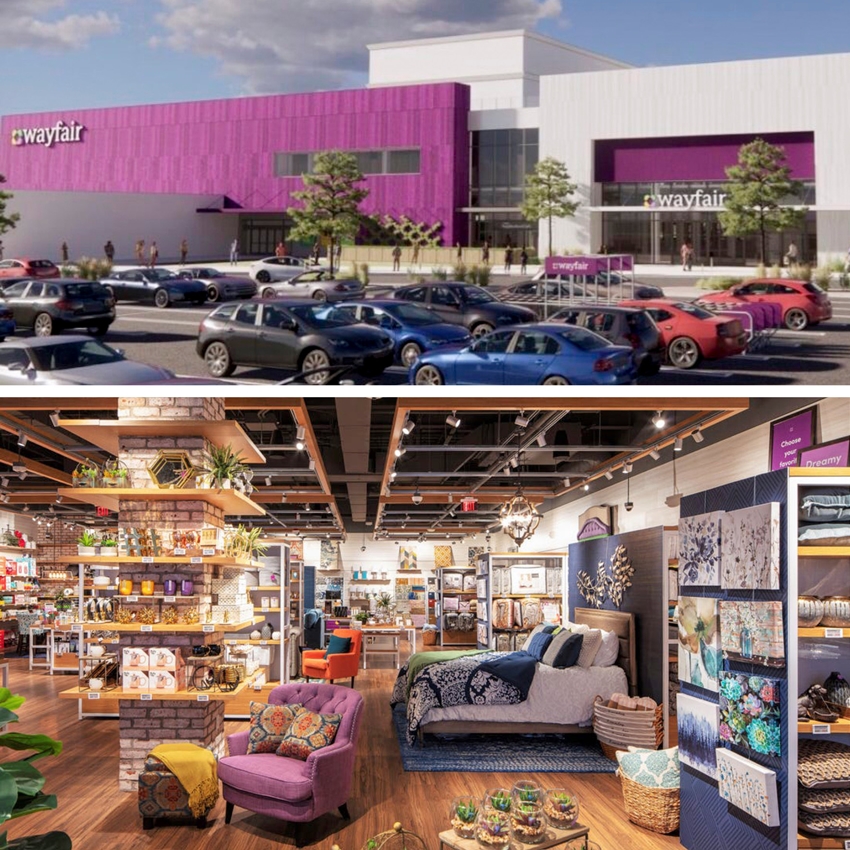Call it omnichannel. Call it platform neutral. Call it be-where-your-customer-is. Whatever you call it, calling it late is a very risky business strategy indeed. And that is the position Wayfair, the big online home furnishings retailer, finds itself in today as it begins – FINALLY – the arduous, time-laden and incredibly expensive process of opening physical stores.
It was just a few short months ago when Wayfair announced what both investors and customers had been asking about for years. In early December it said it would open three stores “in the coming year.”
After dabbling in a test or two, a couple of pop-ups, and a wing and prayer, Wayfair will open at least three stores under two of its sub-brands this year followed by a large-scale location under its flagship namesake next year. It promises this is the start of a big rollout into the physical retail space — but out of the gate, four stores do not a physical retailer make.
Tiptoeing into the Mall
It was just a few short months ago when Wayfair announced what both investors and customers had been asking about for years. In early December it said it would open three stores “in the coming year.” All three would be near its Boston headquarters and assumed to be modestly sized, most probably in the 20,000-square-foot range, give or take a couple of gondolas.
Two will be under its AllModern brand, one in MarketStreet in Lynfield and the other in Legacy Place in Dedham, both open-air centers. The third will be branded with its Joss & Main banner and located in the Burlington Mall in Burlington in what the company says is a “new lifestyle space.” Exact opening dates and specifics on store sizes and format “will be available closer to the openings,” the company said.
Both these brands are heavy on the furniture and home décor accessories assortments, so one can expect room displays and other accouterments of the conventional furniture retail store. It would also make sense that these stores will feature tech components in keeping with Wayfair’s advanced digital and AI capabilities.
In fact, we can probably count on it. “We are introducing a new kind of omnichannel shopping experience powered by the Wayfair platform,” Karen McKibbin, head of physical retail said when announcing the stores. She added, “Inviting our customers to engage with the brands they know and love in an innovative format that blends the best of in-store and online shopping.”
Big-Time in Chicagoland
The physical movement is expected to really ramp up next year with the opening of the first Wayfair-branded location, a 150,000-square-foot store in the Chicago suburb of Wilmette, IL. Housed in a former Carson Pirie Scott mall store, it is expected to open in the second half of the year according to press reports in the local online newsletter, The Record North Shore. The company itself has not confirmed this opening and did not respond to inquiries for comment for this story.
An artist rendering of the Wayfair store showed a two-story building decked out in the company’s signature purple and white color motif but there were few other details or specifics. Again, one can assume it will offer room settings and various tech shopping tools and as the Wayfair assortment extends beyond furniture and décor to housewares, home textiles and other household products it will likely be organized by merchandising areas.
More to Come…But
In its announcement of the first openings later this year, the company said this is just the beginning. “Wayfair plans to launch additional stores representing all five of its brands (the other two are Birch Lane and Perigold) in optimal formats, sizes and geographies over the next two years.” McKibbin, echoing the conclusion just about every digitally native retailer reached years ago, said, “We are focused on creating the best possible experience for our customers. That includes meeting them wherever they are on their shopping journey. “We are focused on building a premier portfolio of specialty concepts,” continued McKibbin. “We look forward to unveiling the next evolution of our specialty retail brands through this exciting new channel.”
Of course, it’s a new channel…for Wayfair, but obviously not for other home furnishings sellers. Competitors such as RoomsToGo with more than 200 stores and Ashley HomeStores with more than 2,000 have been doing the physical store thing for decades. Even regional chains such as Haverty’s and Bob’s Discount Furniture each have more than 100 locations. So-called lifestyle stores like Pottery Barn & Crate & Barrel, even as they are delicately paring down the number of physical locations, each still have nearly 200 and 100, respectively.
And then there’s the store sizes. The Wayfair store in Chicago is a good size, at 150,000-square-feet, but a competitor such as Nebraska Furniture Mart (which is not just in Nebraska and sells far more than just furniture) has several locations topping out at more than 500,000-square-feet. And let’s not forget Ikea, which has a similar wide-ranging assortment comparable to Wayfair and has more than 50 stores in the U.S. alone, most in the 400,000- to 500,000-square-foot range.
Physical Math
Do the math and you see Wayfair has its work cut out for itself if it really wants to have a physical presence in the home furnishings space. And it will need to do this with a balance sheet that has shown only two profitable quarters since going public in 2014. The company’s debt at about $2.6 billion, as listed on its 2020 annual report, is in a well-accepted range to its $14.1 billion in revenue for fiscal 2021. And its assets are substantial, building dozens, even hundreds of stores. But this expansion is a frightfully expensive endeavor. And to do so at the same time it is building out its under-developed distribution center network is even more challenging.
So, this physical manifestation of Wayfair will not be easy. The company has long subscribed to the Amazon school of startups, which is that you build it first and then the profits will follow. It’s worked quite nicely for Amazon, but most of its bottom line comes from non-retail activities such as web services, advertising and commissions on third-party merchandise sales. Wayfair has none of those and needs to get all its earnings out of selling furnishings.
Wayfair has done a pretty terrific job selling all those credenzas, sofas, throw pillows and rugs online. Doing it in stores is going to be something entirely different. Amazon found that out the hard way and just announced it was closing nearly 70 book and general merchandise stores. Wayfair itself closed its only store after less than 18 months in operation. Getting physical, Wayfair is about to find out, is one big stretch.




